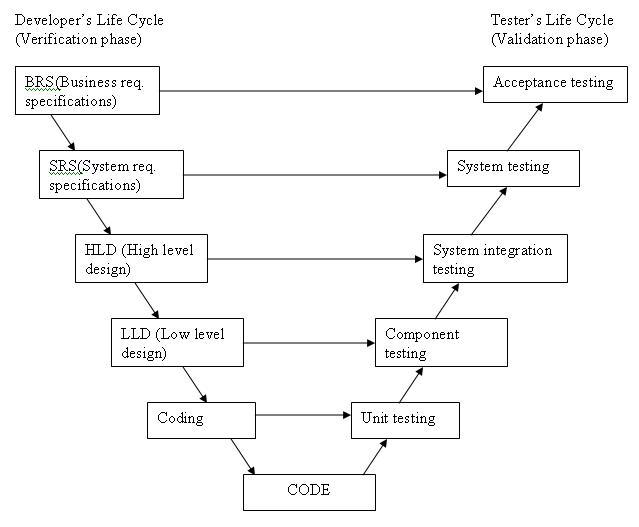V- model means Verification and Validation model. Just like the waterfall model, the V-Shaped life cycle is a sequential path of execution of processes. Each phase must be completed before the next phase begins. Testing of the product is planned in parallel with a corresponding phase of development.

The various phases of the V-model are as follows:
Requirements like BRS and SRS begin the life cycle model just like the waterfall model. But, in this model before development is started, a system test plan is created. The test plan focuses on meeting the functionality specified in the requirements gathering.
The high-level design (HLD) phase focuses on system architecture and design. It provide overview of solution, platform, system, product and service/process. An integration test plan is created in this phase as well in order to test the pieces of the software systems ability to work together.
The low-level design (LLD) phase is where the actual software components are designed. It defines the actual logic for each and every component of the system. Class diagram with all the methods and relation between classes comes under LLD. Component tests are created in this phase as well.
The implementation phase is, again, where all coding takes place. Once coding is complete, the path of execution continues up the right side of the V where the test plans developed earlier are now put to use.
Coding: This is at the bottom of the V-Shape model. Module design is converted into code by developers.
Advantages of V-model:
Simple and easy to use.
Testing activities like planning, test designing happens well before coding. This saves a lot of time. Hence higher chance of success over the waterfall model.
Proactive defect tracking – that is defects are found at early stage.
Avoids the downward flow of the defects.
Works well for small projects where requirements are easily understood.
Disadvantages of V-model:
Very rigid and least flexible.
Software is developed during the implementation phase, so no early prototypes of the software are produced.
If any changes happen in midway, then the test documents along with requirement documents has to be updated.
When to use the V-model:
The V-shaped model should be used for small to medium sized projects where requirements are clearly defined and fixed.
The V-Shaped model should be chosen when ample technical resources are available with needed technical expertise.
High confidence of customer is required for choosing the V-Shaped model approach. Since, no prototypes are produced, there is a very high risk involved in meeting customer expectations.
